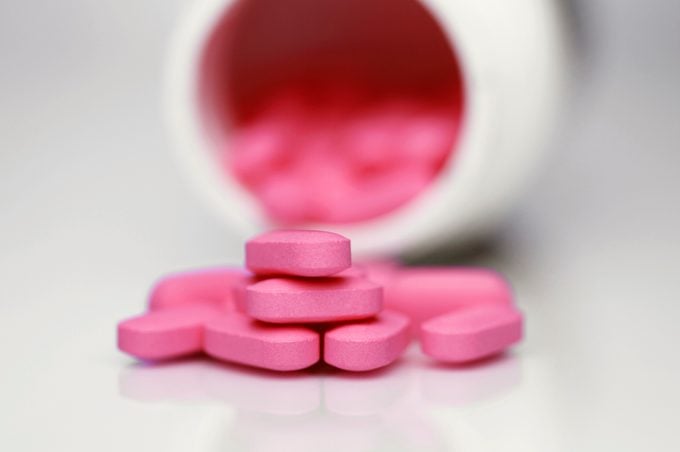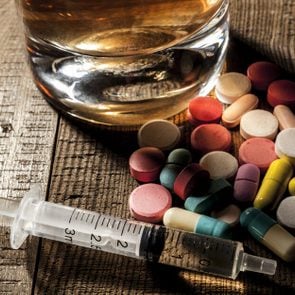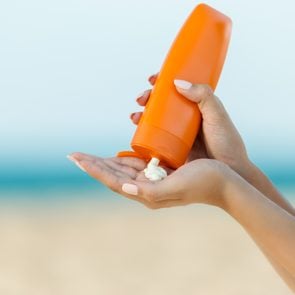Can You Overdose on Benadryl?
Updated: Mar. 03, 2021
TikTok's Benadryl challenge involves taking an overdose of the antihistamine in an effort to induce hallucinations. That's a very bad idea. Experts warn the social media trend is dangerous and can be fatal.
If you’ve heard of the Benadryl challenge on TikTok, you may know that it has resulted in teens and pre-teens overdosing on the allergy medication, which they are taking in high doses in an effort to induce hallucinations.
The challenge entices users to take a dozen or more Benadryl pills to experience the high. In August, a 15-year-old Oklahoma girl died from ingesting too much Benadryl, although it’s not clear how many pills she took. And, unfortunately, this is just one of several cases involving teens and Benadryl overdoses.
So, just how dangerous can the common over-the-counter (OTC) allergy medication be at high doses? Here’s what you need to know about the drug and its potentially dangerous side effects.

What are the active ingredients in Benadryl?
Benadryl’s active ingredient, diphenhydramine, is an antihistamine. Antihistamines treat allergies and nasal conditions, like rhinitis, by reducing or blocking histamines, which reduce symptoms of allergies and inflammation, explains Olivia Audrey, ND, a board-certified naturopathic physician and holistic health coach.
While prescription antihistamines do exist, antihistamines such as Benadryl, cetirizine (Zyrtec), fexofenadine (Allegra), or loratadine (Claritin) are available over the counter. This makes them more attractive to teens, as they are easy to get at a local drugstore. However, besides Benadryl, the other antihistamines are non-sedating and generally would not be thought to cause as much of the “high.”
Can you overdose on Benadryl?
Overdosing on an allergy medication does more than just cause sleepiness. There are other potentially dangerous consequences.
“Though over the counter, one can overdose on Benadryl,” says Felice Gersh, MD, a board-certified OB-GYN and integrative medicine and founder/director of the Integrative Medical Group of Irvine, in California.
While Benadryl is an antihistamine, in the body, histamine acts as a neurotransmitter, or a body chemical messenger, for the brain, spinal cord, and uterus. Specifically, in the brain, histamine works to promote wakefulness and suppress rapid eye movement (REM) sleep, which occurs the first 90 minutes after falling asleep. REM occurs several times in cycles during sleep with normal sleep architecture.
“That is why an overdose has so many manifestations,” says Dr. Gersh, including dangerously low blood pressure, difficulty urinating, and major brain effects.
Philip Bretsky, MD, a board-certified internist and primary care doctor at Santa Monica Primary Care in California, explains that Benadryl is in a class of medication that blocks the effects of the neurotransmitter acetylcholine. This neurotransmitter has receptors all over the body, including the brain and spinal cord, as well as areas including the heart, intestines, and lungs. It signals muscle movement, increases body secretions, dilates blood vessels, and slows heart rate.
As a result, large doses can trigger symptoms ranging from anxiety to a coma, including the hallucinations sought by those doing the Benadryl challenge.
“Hallucinations are often described as “Alice in Wonderland-like” where people appear to become larger and smaller,” says Dr. Bretsky. “Patients with altered mental status from this class of medication are often agitated and may appear to grab invisible objects from the air.”
What are the side effects of a Benadryl overdose?
There are many dangerous side effects that can arise from a Benadryl overdose, Dr. Gersh explains, with side effects including blurred vision, agitation, hallucinations, delirium, tremors, nausea, vomiting, or even seizures.
“I think there is a general tendency to believe that because something is over-the-counter that it is automatically safe. This is not the case,” says Dr. Bretsky. He notes that taking higher-than-recommmend doses or not following the manufacturer’s instructions on other over-the-counter drugs can result in liver failure from acetaminophen (Tylenol), gastrointestinal bleeding from ibuprofen (Advil, Motrin), and days of constipation from loperamide (Immodium).
He added that even ranitidine (Zantac) was removed from the market because the Food and Drug Administration found various formulations of the heartburn drug were contaminated with a carcinogenic compound.
Do teens need smaller doses of Benadryl than adults?
Benadryl offers proper dosing instructions on their website, advising one to two tablets every four to six hours, with no more than six doses in 24 hours. However, teens taking part in the Benadryl challenge have ingested as many as a dozen pills, or even more—double a daily dose—in a single sitting.
Dosing is important when it comes to taking medication safely, says Dr. Bretsky, calling it a pitfall.
“In adult medicine, we rarely dose by weight—we probably should—but weight-based dosing is a mainstay of pediatrics,” Dr. Bretsky explains. He adds that medications are given very differently for a 100-pound teenager versus a 220-pound football player. While most people are aware that overdoses are possible with, say, narcotics, awareness surrounding the danger of improper dosing for over-the-counter medications is less common.
“Dosing medications at a standard adult dose can lead to disastrous consequences for teenagers and adolescents,” says Dr. Bretsky. Other proponents claim that the dosing difference is highly unlikely to an overdose at standard dosing.

The dangers of social media challenges
In 2018, the so-called Tide Pod challenge made headlines when many young people ingested detergent pods and posted their videos on social media. It often baffles adults as to why teens take part in dangerous challenges like these.
It’s partially due to brain development, and partially due to a desire for approval from their peers, says Elisa M. Trucco, associate professor of psychology, director, ReACH Lab at Florida International University’s Center for Children and Families.
“Given how the brain develops, adolescents are in a phase of their life where they are primed to act on impulse without thinking through all the potential negative consequences,” explains Trucco, adding that the area of teens’ brains that deal with control develop more slowly than the area related to rewards.
This, combined with the desire for social status and peer approval, increases the appeal of dangerous activities. “Teens don’t necessarily stop to think about how overdosing on a substance could lead to an emergency room visit. They are more tuned into gaining the more immediate likes, views, and followers on social media,” Trucco says.
The easy accessibility of drugs like Benadryl adds to their appeal, says Delvena Thomas, DO, a Florida-based board-certified psychiatrist. “Teenagers seek out what they believe to be the ‘next best thing’,” explains Dr. Thomas. “Teens are using things like Benadryl for the next best high because it’s easily accessible—probably easily found in all of their homes and can be purchased over the counter in stores and pharmacies without an ID. I haven’t seen Benadryl caged and locked as I have seen the decongestants. It may be time to lock away the pink stuff!” (Beware of the signs of teen drug abuse.)
How to help teens navigate peer pressure
In a world where social media likes are currency, it’s likely impulsive and emotionally vulnerable adolescents and teens who are more likely to take part in challenges. However, Joanna Dodd Massey, communications expert and author of Communicating During a Crisis, counsels parents not to lose hope.
“Today’s teens, who are members of Generation Z, say their most trusted source of information is their peers and family members. This means parents can have a positive influence on their teens, assuming they have an open line of communications,” says Massey, encouraging adults to be transparent, truthful, and timely when communicating with their teens about real dangers stemming from medication, social media, and peer pressure. “When parents tackle these tough subjects head-on, with compassion, clarity, and calm, they can make a difference.”


















